 |
|
888 With ST4 Exhaust Systems – Std and Ducati Performance
Frankly, I now think the ST4 headers are probably the best performance system going for the 851and 888 series, particularly how hard it is to get the older (and far more expensive) ‘spaghetti systems’ these days. How much a bigger system would increase (or decrease) the output, however, I wasn’t sure of. Given the mufflers that came with the DP header set are just the normal DP ST4 mufflers (the now superceded Gia-Co-Moto style), they also fitted the std ST4 headers. Meaning the Staintune mufflers fit the DP header set too. So, I did the next tests in a few steps. First up were the ST4 headers with both Staintune and DP mufflers, then the DP headers with both sets of mufflers. Which gave me a mini muffler shoot out too. All good fun, if not a little time consuming.
The next graph shows the large header comparison with the same mufflers. Std ST4 headers with DP mufflers is green, DP ST4 headers with the DP mufflers is red. As above, the differences between the header sets are pretty obvious. The better performance of the bigger header in the 5-6,000 RPM range is something I have seen with other models, but I wasn’t expecting the big hole from 6,500 to 8,500 RPM. From the graph above, you can see the torque peak the other two curves have is totally missing, and the usual "flattening" after the peak is in fact a dip, although it does come back for a "fourth" peak of sorts. In isolation, it would probably look like a rather flat curve, just not in its present company. I’m really not sure why this occurs, as there isn’t anything in the system that I can see causing an issue like this. It must be related to the diameter of the header, as the x-over design I can’t see creating any problems, and I know either pair of mufflers is just fine. I was rather disappointed to see this, and just can’t explain it. Maybe have to think about it some more. Overall, the small dip of the std ST4 headers down low is more than made up for at the upper end of the rev range. For some reason, it seems that pretty much any capacity of the Desmoquattro engine works well overall with 45mm exhaust header pipes.
Another thing I noted was the difference in fuel required by the two headers sets to make max power through the midrange. The DP headers required quite a bit more fuel than the std ST4 headers, in the 5,000 to 6,500 RPM range where the DP headers make more power. Quite a bit more really, whereas the std ST4 headers pretty much ran the same fuel the original 40mm headers and Megacycle mufflers required for max power. The next two graphs show the power curves for different fuel settings, with fuel added across the whole map in 5% jumps. The DP headers are first, and run from std map to +25%. The std ST4 headers are second, and run from –5.4 to +15%. All these runs were done one after the other, with two runs for each fuel setting generally. Just to make sure they are consistent. This shows the true beauty of the FIM Hand Held Terminal, and adjustable fuel injection in general. To try richer or leaner in real time, you just trim up or down between runs as required. On a dyno with enough air flowing across the bike to keep its temperature constant – like the Dynobike dyno has – you can easily do 20 or so consecutive runs without any concern for temperature variation.
The next graphs (power, then torque) show the muffler comparison with the same headers. Std ST4 headers with Staintune mufflers is green, std ST4 headers with the DP mufflers is red. DP ST4 headers with Staintune mufflers is yellow, DP ST4 headers with DP mufflers is blue. As you can see, there isn’t much between the two muffler designs, but the big DP headers exaggerate the slightly better performance of the DP mufflers in the upper half of the rev range. Having had a bit of a think about this, I figure this is due to the diameter of the muffler entry pipes, where they slip onto the ST4 header sets. On the Staintunes, the tube here is maybe 42mm (certainly no more than 45mm), whereas the DP mufflers are more like 47mm or 50mm. This may cause a slight restriction with the Staintunes. It is exaggerated on the DP headers by the fact that the 50mm headers split into the 47mm x-over, then out into the muffler entry pipes. On the std ST4 headers, the transition from 45mm header into the stamped steel x-over is much less dramatic, and the smaller diameter of the Staintune muffler entry pipe will have much less of an effect. The very minimal difference between the red and green lines at the top end shows that is probably more a problem of diameter mismatch than anything actually wrong with the Staintune design. The Staintunes work a little better under 6,000 RPM, which may be due to the diameter thing working the other way.
The results decided which header/muffler combination went on this 888 for sale, and which one stayed for the 851. That means the 851 is keeping its std ST4 headers and the Staintunes. I was hoping the std ST4 headers would out-do the DP headers a little, but certainly wasn’t looking forward to that hole in the curve. Makes the all std to final "as to be sold" result graph look a bit lame in comparison to what it could be. Reminds me of a certain 900 Monster.
The next thing I tried was reducing the maximum ignition advance. Although I haven’t got the actual map from Duane yet, the WOT line has about 36 degrees @ 3,000 RPM and climbs to 45 or 46 by around 8,000 RPM, and runs out at this. Again, the FIM hand held terminal shows this in real time, another reason taping it to the top of the fuel tank is a very convenient idea. Once I had the "fuel for best power" I reduced the maximum available advance to 42 then 38 degrees. This doesn’t fix the advance at a given number, it just sets the upper limit. Given the consistency of the results, I’ll just show the curves for the DP headers and mufflers. Std advance is red, 42 degrees max is green and 38 degrees max is blue. You can see it liked a little less advance between 6 and 7,000 RPM (38 max), where the advance is around 43 degrees from memory, and was just as happy with 42 degrees max from there up. Although 38 degrees max was not enough above 7,500 RPM. I had mainly been curios to see if this changed the shape of the curve at the top end, but that didn’t happen. I’ll get a printout of the map from Duane at some stage before I sell the bike, and no doubt hassle him to make me a custom chip with both fuel and ignition changes. Just to waste a little more of his time.
The next graph compares this 888 in its final state with the 851SP3 and 888SP4 results from the other reports. When the SP3/4 were first released, they were very flash things, and everyone accepted the higher state of engine tune as necessary to get that kind of power. Indeed, much crap was spoken regarding the "hot bits". I had begun to think that the older SP ‘A’ cams were not much use some time ago, and this curve proves it. From my experience, I feel that these heads really like lift more than duration, a reason the 996 SPS cams work so well. For road based bikes at least. All three bikes in this graph are 888cc, have 33/29mm valves and open airbox lids. Both SP have 45/50mm exhaust in the same style as the std 888 and ST4 headers, although they have 50mm up swept, high mount mufflers. In real terms, the only difference between my 888 and the two SPs are the cams. The fact my 888 out-torques and almost out-powers both SPs doesn’t surprise me that much really, and just comes down to good set up of the std bits and simple mods as required. The only point in my advantage is that they didn’t have ST4 headers back then. The SPs may still be as quick, due to lighter engine internals and close ratio gearboxes, but my 888 has a much smoother curve. Red is my 888, blue is the 851 SP3, and green is the 888 SP4.
So, we come to the end of the 888 testing. The first graph below is for the starting and finishing points, showing how far we’ve come. It is a very nice thing to ride in this state of tune, and way faster than the std bike. All std is green, the final – cams dialed, open airbox lid, ‘zoned’ Megazone chip, std ST4 headers and Staintune mufflers is red. Both power and torque are shown on the same graph. Not that much in terms of mods (or money spent), and all done with no more engine disassembly than removing the valve and belt covers. The bang for buck improvement, in those terms, is very cool.. The DP system turned out to be a bit of a non-performer (maybe a bit harsh, but it certainly didn’t help like I thought it might), as the second graph shows. It will go on the bike for sale, as I have no desire to keep it for the 851. As I said above, however, in isolation the DP system is not too bad. The torque curve shows an almost straight line from 5,000 to 9,000 RPM, and it does make 103 Hp. So it would still be plenty quick to ride, and far gruntier from that fat midrange through to the top end than the std bike. You might not even notice the dip (maybe?).
The final graph shows some steps along the way. Green is all std, pink is all std except for open airbox lid. Yellow is Staintune mufflers, open airbox lid and rezoned fuel. Aqua is std mufflers, cams dialed, open airbox lid and rezoned fuel. Blue is cams dialed, megacycle mufflers, open airbox lid and rezoned fuel. Red is ST4 headers, DP mufflers, cams dialed, open airbox lid and rezoned fuel.
So there you have the 888. That’s pretty much everything I can think of for this bike. I have a couple of other ideas for this style of airbox/exhaust design that I will try on the 851, but for now I am finished. If I was keeping this bike I would add a lightweight flywheel, but everything else is done. Not that I did that much really. I do so many runs simply because I like to answer various question along the way, which I wouldn’t need to do if this was a customer job. The only unknown I had was the DP ST4 full system, which it turns out wasn’t any benefit over the rather less glamorous, but wonderfully effective std ST4 headers. Although, the system didn’t cost me that much (I promised I wouldn’t say), and second hand ST4 headers are not that easy to come across. After which I’d have to buy some ST4 mufflers as well. And fabricate mounting brackets. Home | Blog | Facebook | Service Enquiry | Products | Reports | The Dyno | Disclaimer | Contact Us |


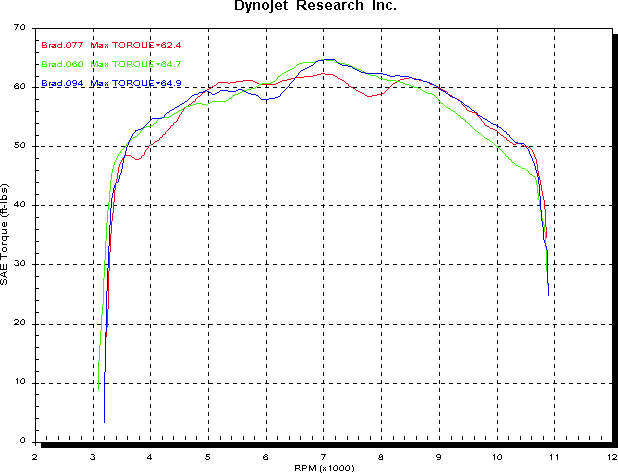 Dynograph courtesy of DYNOBIKE (03) 9553 0018
Dynograph courtesy of DYNOBIKE (03) 9553 0018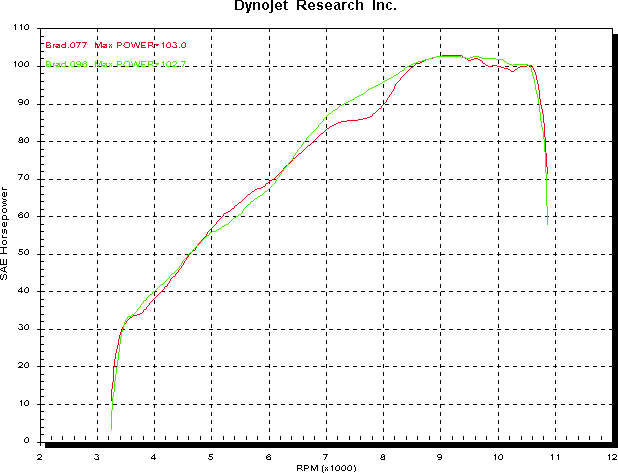
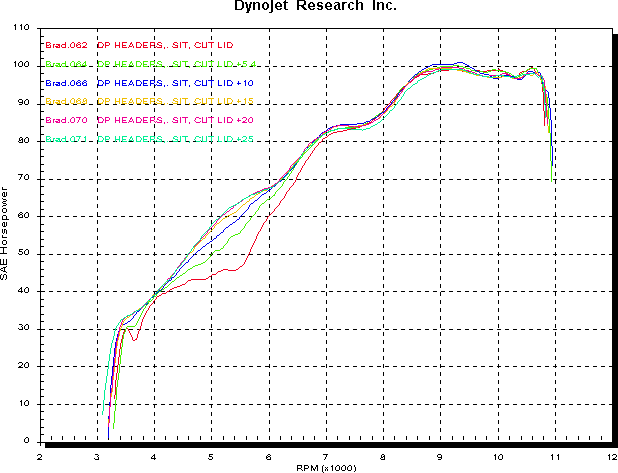
 Dynograph courtesy of DYNOBIKE (03) 9553 0018
Dynograph courtesy of DYNOBIKE (03) 9553 0018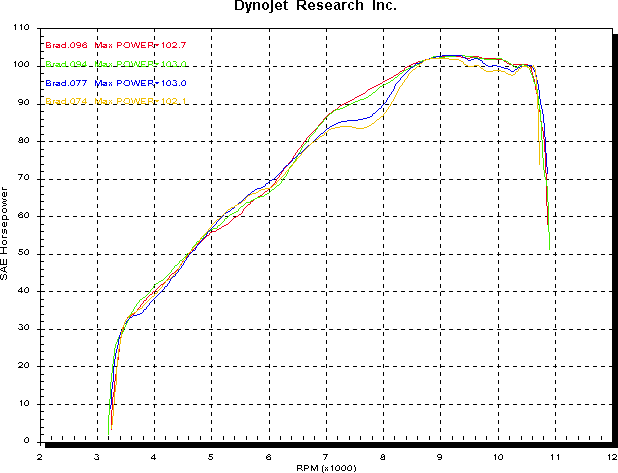
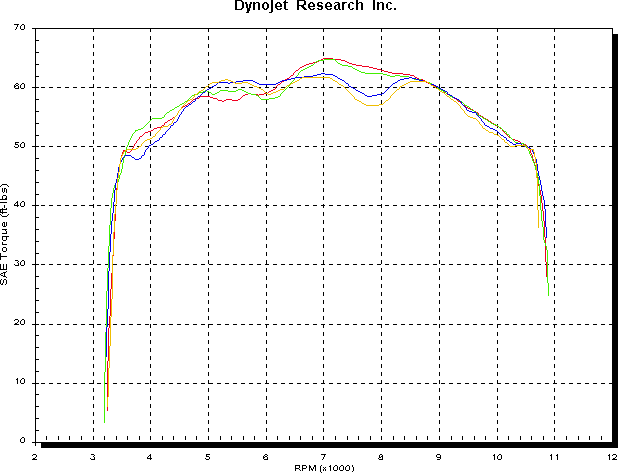 Dynograph courtesy of DYNOBIKE (03) 9553 0018
Dynograph courtesy of DYNOBIKE (03) 9553 0018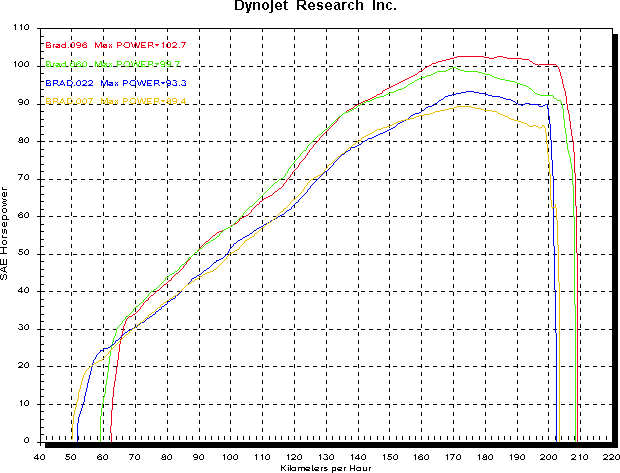
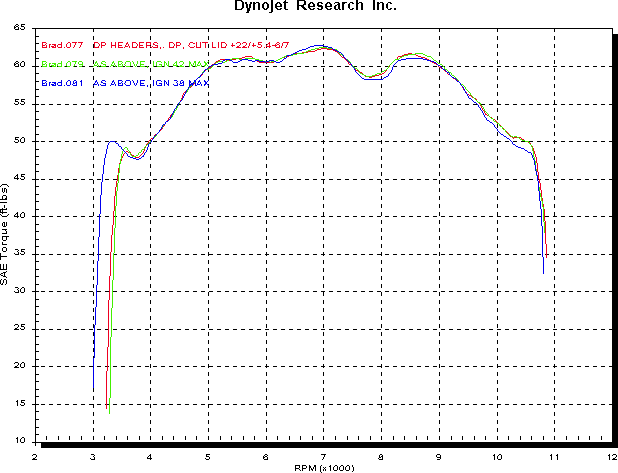


 Dynograph courtesy of DYNOBIKE (03) 9553 0018
Dynograph courtesy of DYNOBIKE (03) 9553 0018